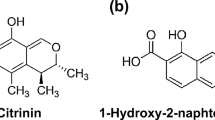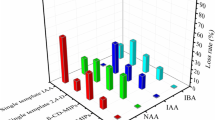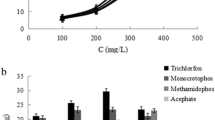Abstract
A novel molecularly imprinted material based on silica microparticles was synthesized by surface polymerization with 3-chloro-1,2-propandiol (3-MCPD) as a template molecule. The molecularly imprinted polymer (MIP) was characterized by infrared spectroscopy and scanning electron microscopy. The adsorption of 3-MCPD by MIP was measured by gas chromatography with electron capture detection (GC-ECD) and an equilibrium binding experiment. Scatchard analysis revealed that the maximum apparent binding capacities of the MIP and non-imprinted polymer (NIP) were 67.64 and 23.31 μmol/g, respectively. The new adsorbent was successfully used in solid-phase extraction (SPE) to selectively enrich and determine 3-MCPD in soy sauce samples. The MIP-SPE column achieves recoveries higher than 92.7 % with a relative standard deviation of less than 1.83 %. The MIP-SPE-GC protocol improved the selectivity and eliminated the effects of template leakage on quantitative analysis and could be used for the determination of 3-MCPD in other complex food samples.

The MIP-SPE column developed by us achieves recoveries higher than 92.7 % with a relative standard deviation of less than 1.83 % for determining the 3-MCPD in the soy sauce matrix (mixed with 3-MCPD, 2-MPCD and 1,3-DCP).









Similar content being viewed by others
References
Crews C, Hasnip S, Chapman S, Hough P, Potter N, Todd J, Brereton P, Matthews W (2003) Survey of chloropropanols in soy sauces and related products purchased in the UK in 2000 and 2002. Food Addit Contam 20:916–922
Baer I, de la Calle B, Taylor P (2010) 3-MCPD in food other than soy sauce or hydrolysed vegetable protein (HVP). Anal Bioanal Chem 396:443–456
Vicente E, Arisseto AP, Monteiro V, Furlani RPZ, Toledo MCF (2011) A survey of chloropropanols (3-MCPD and 1,3-DCP) in soy sauces and similar products from Brazil. Toxicol Lett 205:S145–S146
Crews C, Brereton P, Davies A (2001) The effects of domestic cooking on the levels of 3-monochloropropanediol in foods. Food Addit Contam 18:271–280
Breitling-Utzmann CM, Hrenn H, Haase NU, Unbehend GM (2005) Influence of dough ingredients on 3-chloropropane-1,2-diol (3-MCPD) formation in toast. Food Addit Contam 22:97–103
Cho WS, Han BS, Nam KT, Park K, Choi M, Kim SH, Jeong J, Jang DD (2008) Carcinogenicity study of 3-monochloropropane-1,2-diol in Sprague–Dawley rats. Food Chem Toxicol 46:3172–3177
Byun JA, Ryu MH, Lee JK (2006) The immunomodulatory effects of 3-monochloro-1,2-propanediol on murine splenocyte and peritoneal macrophage function in vitro. Toxicol in Vitro 20:272–278
Egmond H, Schothorst R, Jonker M (2007) Regulations relating to mycotoxins in food. Anal Bioanal Chem 389:147–157
Robert MC, Oberson JM, Stadler RH (2004) Model studied on the formation of monochloropropanediols in the presence of lipase. J Agric Food Chem 52:5102–5108
Kirkland DJ, Henderson L, Marzin D, Müller L, Parry JM, Speit G, Tweats DJ, Williams GM (2005) Testing strategies in mutagenicity and genetic toxicology: an appraisal of the guidelines of the European Scientific Committee for Cosmetics and Non-Food Products for the evaluation of hair dyes. Mutat Res 588:88–105
Xing X, Cao Y, Wang L (2005) Determination of rate constants and activation energy of 3-chloro-1,2-propanediol hydrolysis by capillary electrophoresis with electrochemical detection. J Chromatogr A 1072:267–272
Xing X, Cao Y (2007) Determination of 3-chloro-1,2-propanediol in soy sauces by capillary electrophoresis with electrochemical detection. Food Control 18:167–172
Cifuentes A (2006) Recent advances in the application of capillary electromigration methods for food analysis. Electrophoresis 27:283–303
Pesselman RL, Feit MJ (1988) Determination of residual epichlorohydrin and 3-chloropropanediol in water by gas chromatography with electron-capture detection. J Chromatogr A 439:448–452
Spyres G (1993) Determination of 3-chloropropane-1,2-diol in hydrolysed vegetable proteins by capillary gas chromatography with electrolytic conductivity detection. J Chromatogr A 638:71–74
Racamonde I, González P, Lorenzo RA, Carro AM (2011) Determination of chloropropanols in foods by one-step extraction and derivatization using pressurized liquid extraction and gas chromatography–mass spectrometry. J Chromatogr A 1218:6878–6883
Ma F, Li P, Matthäus B, Zhang W, Zhang Q (2012) Optimization of ultrasonic-assisted extraction of 3-monochloropropane-1,2-diol (MCPD) and analysis of its esters from edible oils by gas chromatography–mass spectrometry. J Sep Sci 35:2241–2248
González P, Racamonde I, Carro AM, Lorenzo RA (2011) Combined solid-phase extraction and gas chromatography–mass spectrometry used for determination of chloropropanols in water. J Sep Sci 34:2697–2704
León N, Yusà V, Pardo O, Pastor A (2008) Determination of 3-MCPD by GC-MS/MS with PTV-LV injector used for a survey of Spanish foodstuffs. Talanta 75:824–831
Küsters M, Bimber U, Ossenbrüggen A, Reeser S, Gallitzendörfer R, Gerhartz M (2010) Rapid and simple micromethod for the simultaneous determination of 3-MCPD and 3-MCPD esters in different foodstuffs. J Agric Food Chem 58:6570–6577
Hamlet CG, Sutton PG (1997) Determination of the chloropropanols, 3-chloro-1,2-propandiol and 2-chloro-1,3-propandiol, in hydrolysed vegetable proteins and seasonings by gas chromatography/ion trap tandem mass spectrometry. Rapid Commum Mass Spectrom 11:1417–1424
Rodman LE, Ross RD (1986) Gas–liquid chromatography of 3-chloropropanediol. J Chromatogr A 369:97–103
Sato H, Kaze N, Yamamoto H, Watanabe Y (2013) 2-monochloro-1, 3-propanediol (2-MCPD) dynamics in DGF standard methods and quantification of 2-MCPD. J Am Oil Chen Soc 90(8):1121–1130
Mamilla RY, Chetyala RK, Venna R, Gajjela R, Katragadda K, Govindasamy S, Mulukutla S, Datta D (2010) A sensitive and selective GC–MS method for analysis of process-related genotoxic impurities in atenolol. Chromatographia 71(7–8):733–736
Carro AM, González P, Lorenzo RA (2013) Simultaneous derivatization and ultrasound-assisted dispersive liquid–liquid microextraction of chloropropanols in soy milk and other aqueous matrices combined with gas-chromatography–mass spectrometry. J Chromatogr A 1319:35–45
Caro E, Marcé RM, Borrull F, Cormack PAG, Sherrington DC (2006) Application of molecularly imprinted polymers to solid-phase extraction of compounds from environmental and biological samples. Trac Trend Anal Chem 25:143–154
Puoci F, Cirillo G, Curcio M, Iemma F, Spizzirri UG, Picci N (2007) Molecularly imprinted solid phase extraction for the selective HPLC determination of α-tocopherol in bay leaves. Anal Chim Acta 593:164–170
Caro E, Masqué N, Marcé RM, Borrull F, Cormack PAG, Sherrington DC (2002) Non-covalent and semi-covalent molecularly imprinted polymers for selective on-line solid-phase extraction of 4-nitrophenol from water samples. J Chromatogr A 963:169–178
Anderson RA, Ariffin MM, Cormack PAG, Miller EI (2008) Comparison of molecularly imprinted solid-phase extraction (MISPE) with classical solid-phase extraction (SPE) for the detection of benzodiazepines in post-mortem hair samples. Forensic Sci Int 174:40–46
Benito-Peña E, Urraca JL, Sellergren B, Moreno-Bondi MC (2008) Solid-phase extraction of fluoroquinolones from aqueous samples using a water-compatible stochiometrically imprinted polymer. J Chromatogr A 1208:62–70
Liang RN, Song DA, Zhang RM, Qin W (2010) Potentiometric sensing of neutral species based on a uniform-sized molecularly imprinted polymer as a receptor. Angew Chem 122:2610–2613
Pan J, Yao H, Guan W, Ou H, Huo P, Wang X, Zou X, Li C (2011) Selective adsorption of 2,6-dichlorophenol by surface imprinted polymers using polyaniline/silica gel composites as functional support: equilibrium, kinetics, thermodynamics modeling. Chem Eng J 172:847–855
Zhu R, Zhao W, Zhai M, Wei F, Cai Z, Sheng N, Hu Q (2010) Molecularly imprinted layer-coated silica nanoparticles for selective solid-phase extraction of bisphenol A from chemical cleansing and cosmetics samples. Anal Chim Acta 658:209–216
Lorenzo AR, Carro MA, Alvarez-Lorenzo C, Concheiro A (2011) To remove or not to remove? The challenge of extracting the template to make the cavities available in molecularly imprinted polymers (MIPs). Int J Mol Sci 12(7):4327–4347
Tokonami S, Shiigi H, Nagaoka T (2009) Review: micro- and nanosized molecularly imprinted polymers for high-throughput analytical applications. Anal Chim Acta 641:7–13
Luo W, Zhu L, Yu C, Tang H, Yu H, Li X, Zhang X (2008) Synthesis of surface molecularly imprinted silica micro-particles in aqueous solution and the usage for selective off-line solid-phase extraction of 2,4-dinitrophenol from water matrixes. Anal Chim Acta 618:147–156
Kandimalla BV, Ju HX (2004) Molecular imprinting: a dynamic technique for diverse applications in analytical chemistry. Anal Bioanal Chem 380:587–605
Sun HW, Qiao FX (2008) Recognition mechanism of water-compatible molecularly imprinted solid-phase extraction and determination of nine quinolones in urine by high performance liquid chromatography. J Chromatogr A 1212:1–9
Yu C, Mosbach K (1997) Molecular imprinting utilizing an amide functional group for hydrogen bonding leading to highly efficient polymers. J Org Chem 62(12):4057–4064
Chandy G, Zampighi GA, Kreman M et al (1997) Comparison of the water transporting properties of MIP and AQP1. J Membr Biol 159(1):29–39
Jiang D, Sun XL, Zhang Y (2012) Preparation and application of acrylamide molecularly imprinted composite solid-phase extraction materials. Anal Methods 4(11):3760–3766
Anderson LI (2000) Molecular imprinting for drug bioanalysis: a review on the application of imprinted polymers to solid-phase extraction and binding assay. J Chromatogr Biomed Appl 739(1):163–173
Acknowledgments
The authors are mainly grateful to “973” National Basic Research Program of China (No. 2012CB720804), and the Commonweal Project of the Ministry of Agriculture (No. 201203069-1) for funding the research. This work has also been supported by Program for New Century Excellent Talents in Jiangsu University, Synergetic Innovation Center of Food Safety & Quality Control Jiangsu Province, the Priority Academic Program Development of Jiangsu Higher Education Institutions, and partly supported by “Risk Assessment for Agro-products Quality & Safety” Financial Fund of Ministry of Agriculture.
Author information
Authors and Affiliations
Corresponding authors
Rights and permissions
About this article
Cite this article
Li, Y., Zheng, C., Sun, X. et al. Identification of 3-chloro-1,2-propandiol using molecularly imprinted composite solid-phase extraction materials. Anal Bioanal Chem 406, 6319–6327 (2014). https://doi.org/10.1007/s00216-014-8059-2
Received:
Revised:
Accepted:
Published:
Issue Date:
DOI: https://doi.org/10.1007/s00216-014-8059-2




